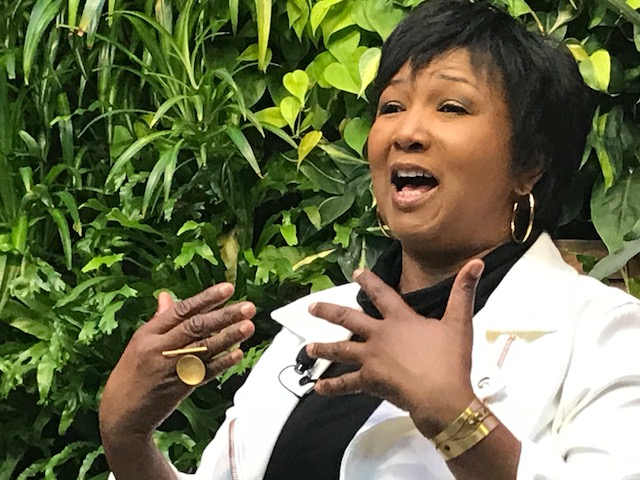[ad_1]

When NASA astronauts rocket into space, they are allowed to take a few souvenirs from Earth with them. Dr. Mae Jemison, the first African American woman to go on such a mission, revealed details about her 1992 Space Shuttle Endeavor keepsakes to a riveted, mostly black audience gathered at SAP’s San Francisco headquarters Friday night.
She took a Bundu statue from the Women and Girls Society of West Africa, a pink and green AKA banner, the flag of the Organization of African Unity (OAU), and a picture of Alvin Ailey’s Judith Jamison performing a dance called, “Cry.” It turns out that Jemison, the astronaut, was at one time seriously considering following in the footsteps of Jamison, the dance legend.
How did she choose those items to carry into space with her? “I wanted to include people and organizations that had not been included because space belongs to all of us,” Jemison said. “We don’t all want to go, but we all wonder what’s up there.”
In a far-reaching fireside chat Friday night, hosted by the diversity and inclusion consultancy Culture Shift Labs along with SAP.io, Jemison talked about the biases she faced from the very start. When she first told her kindergarten teacher she wanted to be a scientist, the teacher’s response was, “Don’t you mean [a] nurse?” Incensed, even at age 5, Jemison repeated herself and the rest is, literally, history.
Although her resolve ultimately held, Jemison was not without her moments of doubt. As a student at Stanford University, where she majored in chemical engineering and African and African American studies, Jemison also took dance classes and choreographed a musical called, “Out of the Shadows.”
In fact, she had already been accepted into medical school and was conflicted about whether to take that route or go to New York City to pursue a dance career. “My mother helped me decide,” Jemison recalled, laughing. “She said you can always dance if you’re a doctor, but you can’t necessarily be a doctor if you’re a dancer.”
Despite her choice to pursue a career in science, Jemison doesn’t see the two as unrelated.
“Being an astronaut, you’re always training and rehearsing,” Jemison said. “You have to think about what you’re doing. You have to be able to take critique. You have to be able to critique yourself. It’s very physical. You have to be healthy. You have to coordinate things—you can’t just pay attention to the engine, you have to pay attention to everything that’s happening around you.” The defining characteristics of a good dancer, she said, are very similar.
As an engineer, physician, astronaut, professor, and entrepreneur, she is an interdisciplinary icon who has distinguished herself at every turn. Her current work, as the principal of 100 Year Starship, is focused on creating a business plan that can sustain the research needed for interstellar travel. She also leads the Dorothy Jemison Foundation for Excellence, which is about to launch its Look Up campaign, designed to capture 24 hours of lay people’s view from below in August (for more information, go to lookuponesky.org).
But this former Peace Corp volunteer made it clear that while she has traveled as far from the planet Earth as one can go, she still views the world through a lens that was crafted on the South Side of Chicago in a home where her confidence was nurtured and her curiosity embraced. Without them, she would never have achieved what she has.
After showing off her Black Panther phone case (“I had it before the movie,” she bragged) and crossing her arms across her chest in the Wakanda warrior’s salute, she wowed the room full of mostly African American tech entrepreneurs, executives, and investors, with her frank insights and details of her journey that most had never been heard before.
Ram Jambunathan, SVP and managing director on SAP.io, seemed to be nearly as impressed by the audience as he was the evening’s headliner. “It was so empowering to see this group which you don’t typically see in Silicon Valley,” he said. “When you think of Silicon Valley entrepreneurship, you tend to default to the regular stereotypes and regular thinking around white males or Asians. Tonight we saw a much different vision of Silicon Valley as well as an astronaut who just happens to be African American and just happens to be a woman. It was incredibly inspiring.”
[ad_2]
Source link

